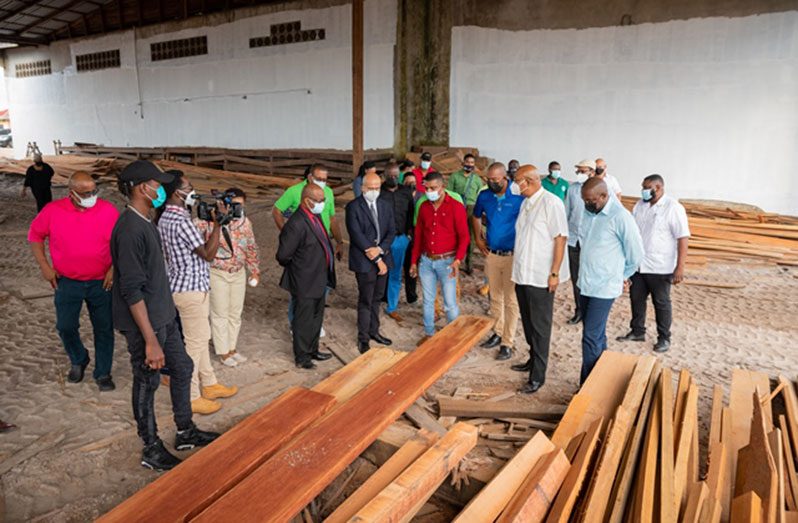FOLLOWING a recent visit to Guyana by a high-level Barbados team aimed at exploring investment opportunities and to strengthen relations between the two Caribbean Community (CARICOM) nations, the delegation has expressed an interest in converting waste from sawmills into value-added products.
The team, headed by Barbados Minister of Housing, Lands and Maintenance, Dr. William Duguid, spent three days in Guyana exploring opportunities in Guyana’s housing and construction sectors. During this time, they also met with several senior government officials and representatives of the private sector.
On Sunday, the delegation toured several facilities in Region 10 including the Chetram Brothers Sawmill, located in Amelia’s Ward, Linden, where they witnessed the processing of logs into lumber, a process which results in a large quantity of waste, which can be recycled.
Speaking to the Guyana Chronicle via telephone on Monday, Amar Chetram of Chetram Brothers Sawmill explained that when a log is “cut” the miller recovers approximately 40-55 per cent of the log, which leaves the remainder, including the sawdust, scraps and other materials, as waste to be disposed of.
However, there is a wide range of opportunities for utilising this waste, including pulp for use in paper production and energy recovery. In these regards, the Barbados delegation disclosed their interest in setting up a facility in the locality to compress the waste, and to export it to Barbados, for their own use.
Over the years many mills have regarded wood waste as a troublesome by-product of the sawmilling operation, resulting in it being disposed of as landfill, or it being incinerated. Locally, the sawdust and scraps are also usually used for landfill, or for agricultural purposes.
“Because of the volume we are always looking for a way to get rid of this stuff and to also add some value to it and get something out of it … this will create jobs, this will help with getting rid of the waste and at the same time it will help to bring some more profitability within the sawmill industry itself,” Chetram said.
“When you utilise 1,000 cubic metres log a month, and 500 gone to waste, it’s an average of over US$60,000 every month that actually goes to waste because a cubic metre of log is around US$120,” he said, highlighting the loss of profits due to failure of fully utilising the product.
EAGER
Cognisant that some countries are utilising 100 per cent of the logs, Chetram is eager for the operations to get up and running as himself, and others have been calling for investments of this nature for a long while, and have even attempted to source markets for the waste products.
“We would have checked several times online and try to speak to different companies in terms of how much it will cost to set up a system like this and it’s very expensive, you’re talking about over US$10 million to get all of this equipment,” Chetram said.
“For years now we have been trying to find some use for our waste because the cost of waste is 50 per cent the cost of production. So, if we can be able to sell our waste and get back some money from that, then we can be able to subsidise the cost of the material we are selling,” he added.
Minister of Public Works, Bishop Juan Edghill, who accompanied the team on Sunday, told the Guyana Chronicle that the visiting delegation enquired about materials for road construction and building construction, as well as biomass materials such as the sawdust to have it exported to Barbados.
He disclosed that talks were also held over Guyana sourcing bitumen from Barbados, where it is produced. Bitumen is actually the liquid binder that holds asphalt together. Asphalt is already manufactured locally.
“I welcome the engagement; I believe it’s a good direction we are going … they spoke about buying stone from Guyana and those barges have to come to pick up, so we must look and see how we can trade, what we can get from Barbados and what Barbados can get from Guyana,” Edghill said.
He continued: “I think what is most important is that as small countries we develop synergies and networking relationships that will lead to the ultimate development of all our people; and as CARICOM we have to lend support to each other, ensure opportunities are offered to each other.”
While in Barbados for the 15th Session of the United Nations Conference on Trade and Development (UNCTAD 15) earlier in October, President Ali and Prime Minister of Barbados, Mia Mottley, engaged in bilateral discussions, as they sought to strengthen relations between the two nations.
President Ali and Prime Minister Mottley had also discussed several initiatives to advance cooperation and investment in the areas of agriculture and fisheries, oil and gas, mining, forestry, tourism, the hospitality industry, transportation, housing and water resources.




.png)









